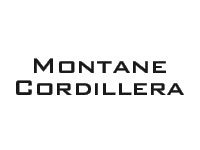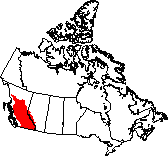|
Location
| Climate | Geology and geography
| Flora and fauna | Humans | Images
Location
This ecozone covers most of southern British Columbia and some of southwestern
Alberta.
Climate
This is the most diverse of the country's ecozones in all respects.
The effects of two mountain ranges means that climate varies in all
three dimensions. The average annual temperatures in the north of the
ecozone is 0.5ºC, in the south 7.5ºC. The dry summers and wetter winters
alike are mild, though increased elevation brings lower temperatures.
The Coast Mountains force
air masses to rise, where they cool off and lose their moisture as rain
or snow, a phenomenon known as orographic precipitation. The western
side of the Coast Mountains receives 1200 to 1500mm of precipitation
in this way, while the eastern side receives only 300mm in the south
and 500 to 800mm in the north and interior due to the dry air that makes
it over the mountains. The Rocky Mountains at the eastern edge of the
ecozone again catch precipitation, bringing 1200mm of precipitation
annually to the western side of the mountains.
Geology
and Geography
The mountains that make up much of the ecozone are formed of faulted
sedimentary rock. The plains and valleys here often consist of glacial
moraine or deposits from ancient lakes.
Flora
and Fauna
Plants
Plants in the ecozone
are as varied as the landforms they grow on. Vegetation that may be
common in one area are often completely absent from another.
Trees in the area include Engelmann
spruce, alpine
fir, interior
Douglas fir, lodgepole
pine, western
white pine, Rocky
Mountain ponderosa pine, trembling
aspen, western
hemlock, Rocky
Mountain red cedar, balsam
poplar, paper
birch, black
spruce, white
spruce, and western
larch. Some of the other species found here are sagebrush, rabbitbrush,
antelope-bush, mountain
avens, bunchgrass, pine grass, and bluebunch wheat grass.
Animals
Mammals
The large herbivores include caribou,
mule deer,
white-tailed
deer, moose,
mountain
goat, California
bighorn sheep, and American
elk. The large carnivores are the black
bear, grizzly
bear, wolf,
lynx,
bobcat,
and cougar. Some of the small herbivores here are hoary
marmot, yellowbelly
marmot, Columbian
ground squirrel, beaver,
golden-mantled
squirrel, yellow
pine chipmunk, redtail
chipmunk, beaver,
northern bog lemming,
and pika. Small
carnivores that are found here include coyote,
red fox,
marten,
wolverine,
muskrat,
badger,
marten,
mink, pallid
bat, and striped
skunk.
Birds
Birds of prey such as northern
saw-whet owl, short-eared
owl, long-eared
owl, burrowing
owl, cooper's hawk,
red-tailed hawk,
sharp-shinned hawk,
northern goshawk,
and turkey vulture
are found here. The shorebirds and seabirds of the area include long-billed
curlew, spotted
sandpiper, american
bittern, common
snipe, killdeer,
and black tern.
Songbirds of the Montane
Cordillera include Stellar’s
jay, black-billed
magpie, sage
thrasher, white-throated
swift, red-winged
blackbird, cedar
waxwing, cassin's
finch, house finch,
purple finch, brown
creeper, and American
dipper. Waterfowl
that are found here include sandhill
crane, northern
pintail, blue-winged
teal, mallard,
gadwall, redhead,
ring-necked duck,
canvasback, and
Canada goose. The
birds of the forest include blue
grouse, sharp-tailed
grouse, spruce
grouse, chukar,
California quail,
Lewis' woodpecker,
and downy woodpecker.
Amphibians and Reptiles
Some of the characteristic frogs and toads of the area are the wood
frog, spotted frog,
and western toad.
One of the salamander species present here is the long-toed
salamander. Snakes found in the region include rubber
boa, common garter
snake, racer,
western rattlesnake,
night snake, and
western terrestrial
garter snake. One of the lizards found here is the western
skink.
Fish
Fish species that live in the ecozone include lake whitefish, chiselmouth,
lake chub, peamouth, leopard dace, and redside shiner. White sturgeon
and sockeye salmon both come to freshwater to spawn.
Molluscs
Molluscs found here include pig-toe,
western-river
pearl mussel, western
floater, and arctic-alpine
fingernail clam.
Insects
A few of the insects that live here are red
turpentine beetle, boreal
spittlebug, spring
azure, mourning
cloak, and migratory
grasshopper.
Humans
Cattle grazing, forestry and mining are three of the major activities
here. These and population growth all put pressure on the natural systems
and even the many provincial parks in the ecozone through encroachment
and habitat fragmentation. Tourism is also having an increasingly large
effect on the area.
Images
Skyline
Trail, Jasper National Park, Alberta
Skyline
Trail, Jasper National Park, Alberta
Jasper
National Park, Alberta
Sunwapta
River, Jasper National Park, Alberta
Mount
Edith Cavell, Jasper National Park, Alberta
Kootenay
National Park
Kootenay
National Park
Old
Man River
Burstall
Pass, Peter Lougheed Provincial Park
Helmcken
Falls, Wells Gray National Park, British Columbia
Iceline
Trail, Yoho National Park, British Columbia
Saskatchewan
River, Banff, Alberta
Desert
 

|
|



